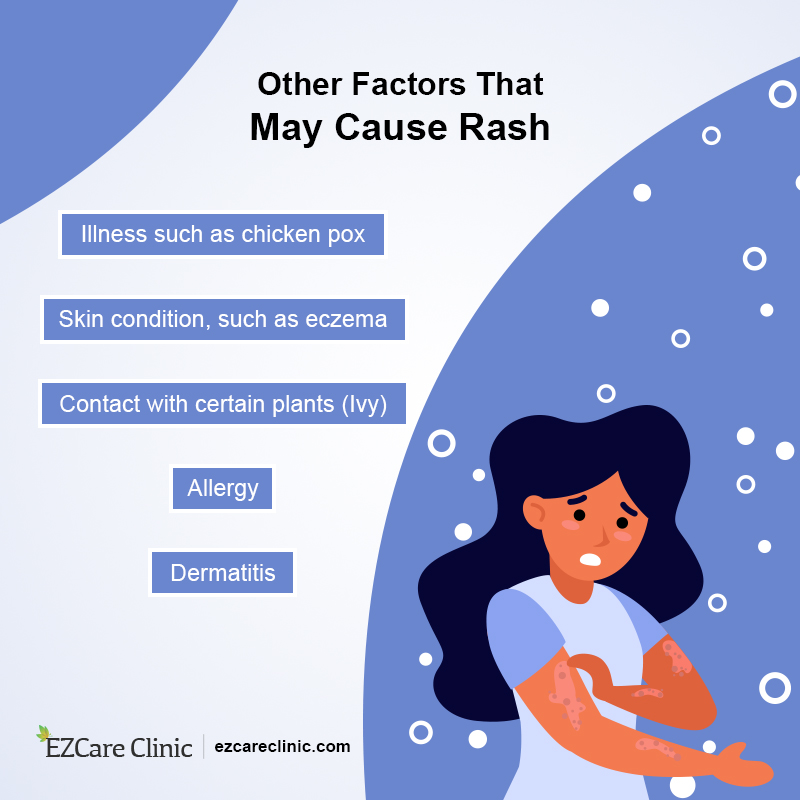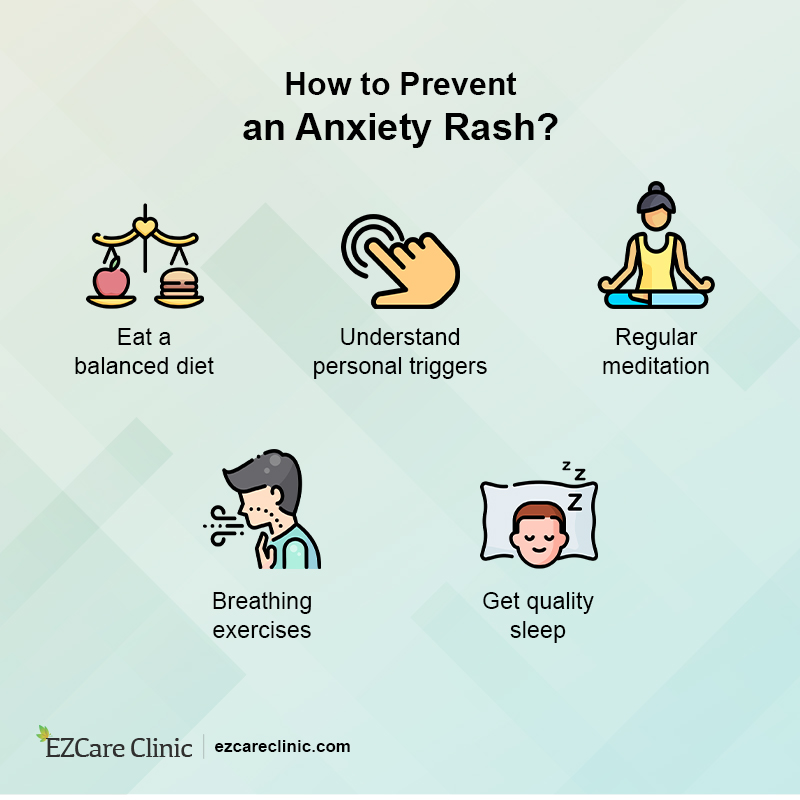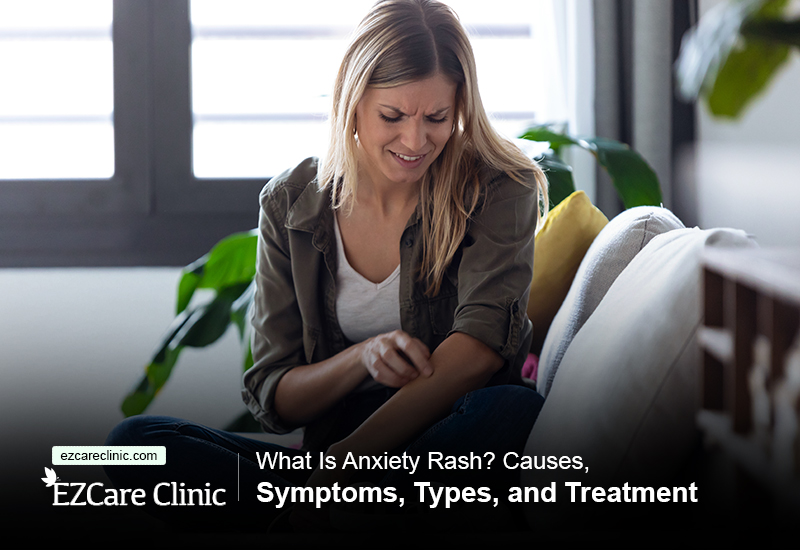Anxiety rashes or hives are red bumps on the skin that appear after a person has had an anxiety attack.
As part of the body’s response to stress, increased adrenaline and cortisol levels in your blood vessels cause them to dilate and allow more histamine than normal into surrounding tissue, causing swelling and itchiness.
Anxiety does not only affect you mentally but also physically- Click below to schedule your appointment with a mental health professional.
The Appearance of an Anxiety Rash
Anxiety rash affects just about any part of your body where there are sweat glands, and capillaries close together, such as:
- Face
- Neck
- Back
- Genitals
- Armpits
- Chest
These rashes can also appear elsewhere if you have sensitive skin.
Anxiety rash can be extremely uncomfortable and sometimes painful. You may even want to scratch the affected area, which only worsens the problem because it causes more histamine-containing cells to enter your skin tissue.
Types of Anxiety Rash
- The most common type of nervous rash is contact dermatitis which usually affects the skin surrounding the lips.
- It may also develop on the face, neck, and chest in severe cases. Allergens like cosmetics or toothpaste bring about this type of nervous rash.
- Another type of rash is called seborrheic dermatitis, which mainly affects the creases of the nose, eyebrows, eyelids, and behind ears.
- It looks like dandruff or scaly patches that are either red or yellowish-brown with greasy scales (looks similar to cradle cap).
- This type of nervous rashes is often mistaken for acne-causing pimples unless an experienced clinician examines you accordingly.
- The last one is angioneurotic edema, where there’s swelling along with itchiness. This is brought about by an allergic reaction as well.

Causes of Rash
Symptoms of Anxiety Rash
Symptoms of anxiety rash include:
- Sudden, intense discomfort or itching in the affected area
- Redness, swelling, and blisters
- Red or brownish patches on the skin surface
In some cases, anxiety rash can lead to a fever or flu-like symptoms such as chills and headaches.
Look out for these signs and have yourself examined by a dermatologist immediately to avoid further infections.
Causes of Anxiety Rash
There are times when this disorder can have physical causes like
As a general rule, these kinds of allergies are usually connected with other physical conditions like:
- Asthma
- Hay fever
- Food intolerance
Anxiety rash can also be a reaction to:
- Anti-seizure medications
- Antidepressants
- Certain blood pressure drugs
In order to get the right cause of anxiety rash diagnosed and treated, click below to schedule your appointment with a mental health professional.
Eating foods such as certain fruits, vegetables and nuts can also cause anxiety rash. It can also occur as part of a generalized anxiety disorder (GAD), in which case it is necessary to seek professional help.
There are other causes too which result in a flare-up like sunburns, infections, allergies, etc. For instance, if you scratch your arms multiple times for itching, it will eventually lead to rashes called neurotic excoriations.
Effects of Anxiety Rash
The appearance of an anxiety rash is accompanied by emotional effects such as psychological stress, which can cause further itching and irritation to the surrounding skin.
Other effects of anxiety rash include:
- Irritability
- Panic Attacks
- Chest pain or discomfort
The appearance of an anxiety rash is also associated with other symptoms such as:
- Nausea
- Shaking
- Vomiting
Treatment of Anxiety Rash
Anxiety rashes can be unsightly. The good news for sufferers is that it can subside without treatment. Mild cases are usually treated at home by reducing stress levels through physical activity or relaxation techniques.
However, there are several cases where the patient must seek immediate medical help to prevent infections and skin problems such as:
- Melanoma
- Shingles
- Herpes zoster

How to Prevent an Anxiety Rash?
Anxiety rash is diagnosed through proper examination and evaluation of all symptoms. The doctor also tries to find out if there is any emotional or physical stress that triggers the itchy feeling, which may lead to anxiety rash formation.
After coming up with a diagnosis, the doctor may come up with either of two treatments.
They may prescribe the patient antihistamine medications to help reduce itching and inflammation.
These drugs must be taken as directed. In case allergy medication does not work, the doctor may prescribe corticosteroids cream. This helps decrease swelling and redness from occurring during the treatment process for anxiety disorder.
Antibiotics are given orally or intravenously in case of a bacterial infection. In addition, the doctor may also prescribe counseling sessions to help a patient deal with stress more effectively and improve their lifestyle. They may also prescribe treatment with antidepressants like selective serotonin reuptake inhibitors (SSRIs).
In general, there are a lot of factors that may lead to the appearance of nervous rashes. It can be due to stress or emotional triggers like anger and sadness, which might trigger itching. But often, it’s not caused by these emotions but by external irritants.
Schedule your appointment and let our expert ease the uncomfortable physical symptoms of anxiety.
Treatment of anxiety rash is not a complex process. However, the patient needs to follow the doctor’s instructions for effective results and prevent further skin problems.
If you are experiencing anxiety or severe stress, you are not alone.
At EZCare Clinic, we can provide options to help you deal with anxiety disorders, improving your quality of life. For more information, contact us or schedule your appointment by clicking the banner below.

